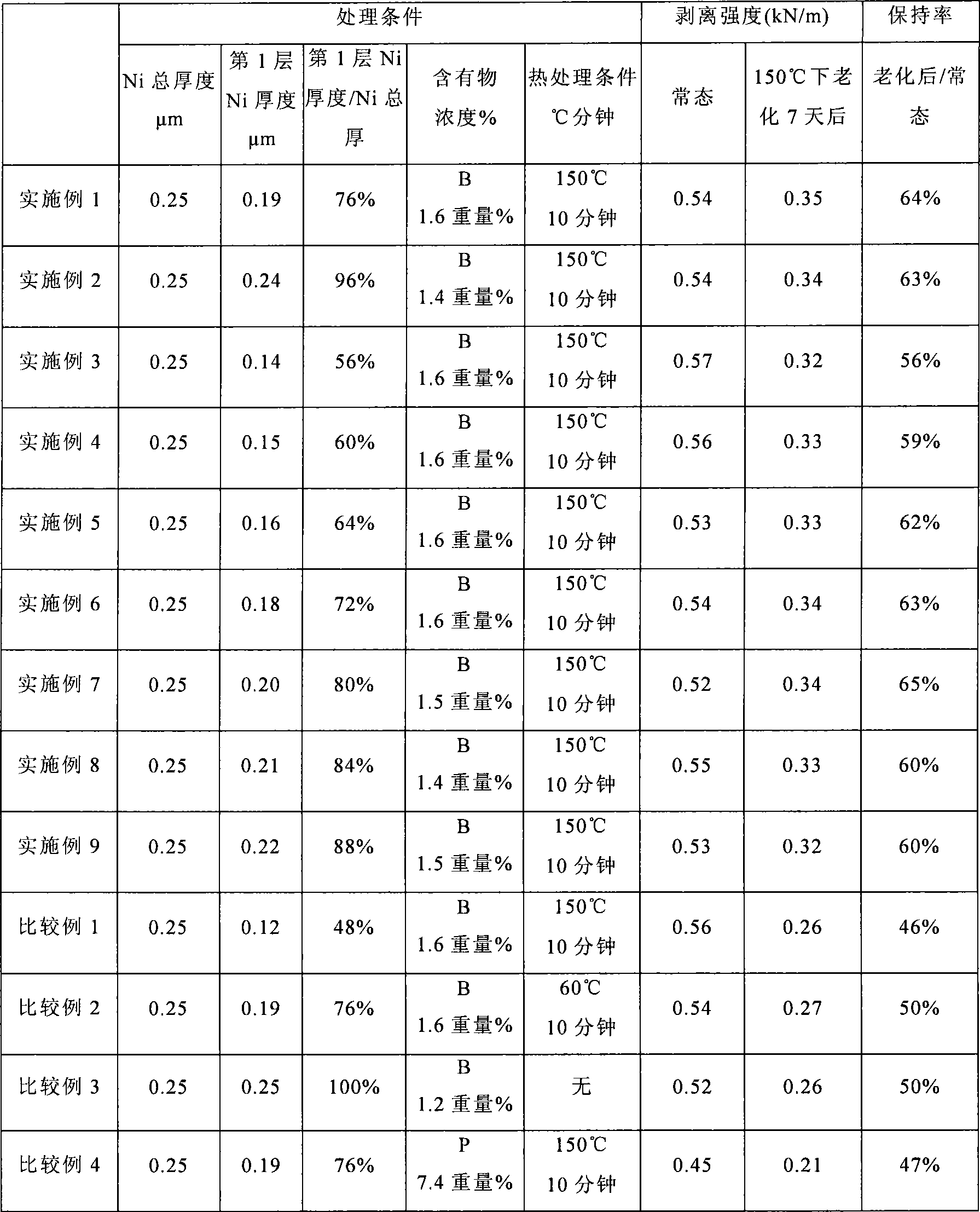Method for production of metal-coated polyimide resin substrate having excellent thermal aging resistance property
A technology of coating polyimide resin and polyimide resin, which is applied in chemical instruments and methods, improvement of metal adhesion of insulating substrates, liquid chemical plating, etc., can solve the problem of difficulty in forming fine patterns, poor etchability, etc. problem, to achieve the effect of improving adhesion and improving heat aging resistance
- Summary
- Abstract
- Description
- Claims
- Application Information
AI Technical Summary
Problems solved by technology
Method used
Image
Examples
Embodiment 1
[0047] As a hydrophilic treatment, a polyimide resin film (DuPont: Kapton 150E) was immersed in a 100 g / L potassium hydroxide aqueous solution at 25° C. for 3 minutes, and then washed with pure water. As a catalyst imparting process, immerse at 50° C. for 10 minutes in a solution (Nikko Metal Co., Ltd.: PM-A) obtained by mixing or reacting a silane coupling agent having a functional group having metal trapping performance and a noble metal compound in advance, Then wash with pure water. Thereafter, as a catalyst activation treatment, the catalyst was immersed in a reducing agent solution (Nikko Metal Co., Ltd.: PM-B) at 50°C for 3 minutes, and then washed with pure water.
[0048] As the first plating step, a nickel-boron electroless plating solution (Nikko Metal Plating Co., Ltd.: Nicom HB) was used to form a 0.19 μm nickel layer (containing 1.6% by weight B) as shown in Table 1, and pure Wash with water. Then, moisture was removed, and then heat treatment was performed at ...
Embodiment 2
[0053] In the nickel plating step of Example 1, as the first plating step, a nickel-boron electroless plating solution (Nikko Metal Plating Co., Ltd.: Nicom HB) was used to form a nickel layer of 0.24 μm (containing 1.4% by weight of B). , and wash with pure water. Furthermore, moisture was removed, and heat-processing was performed in air|atmosphere at 150 degreeC for 10 minutes after that.
[0054] Next, as a second plating step, a nickel layer of 0.01 μm was formed using the same nickel plating solution as above to form a nickel layer of 0.25 μm in total (first plating+second plating). The ratio of the thickness of the first nickel layer to the total thickness reaches 96%.
[0055] Except for this, the same process as in Example 1 was performed. Table 1 also shows the measurement results such as the peel strength at the time of 90° peeling.
[0056] As a result, the normal peel strength was 0.54 kN / m, the peel strength after aging at 150° C. for 7 days was 0.34 kN / m, and...
Embodiment 3
[0060] In the nickel plating step of Example 1, as the first plating step, a nickel-boron electroless plating solution (Nikko Metal Plating Co., Ltd.: Nicom HB) was used to form a nickel layer of 0.14 μm (containing 1.6% by weight of B). , and wash with pure water. Furthermore, after removing moisture, heat treatment was performed in the air at 150° C. for 10 minutes.
[0061] Next, as a second plating step, a nickel layer of 0.11 μm was formed using the same nickel plating solution as above to form a nickel layer of 0.25 μm in total (first plating+second plating). The ratio of the thickness of the first nickel layer to the total thickness reaches 56%.
[0062] Except for this, the same process as in Example 1 was performed. Table 1 also shows the measurement results such as the peel strength at the time of 90° peeling.
PUM
| Property | Measurement | Unit |
|---|---|---|
| Normal peel strength | aaaaa | aaaaa |
| Peel strength | aaaaa | aaaaa |
| Peel strength | aaaaa | aaaaa |
Abstract
Description
Claims
Application Information
 Login to view more
Login to view more - R&D Engineer
- R&D Manager
- IP Professional
- Industry Leading Data Capabilities
- Powerful AI technology
- Patent DNA Extraction
Browse by: Latest US Patents, China's latest patents, Technical Efficacy Thesaurus, Application Domain, Technology Topic.
© 2024 PatSnap. All rights reserved.Legal|Privacy policy|Modern Slavery Act Transparency Statement|Sitemap

